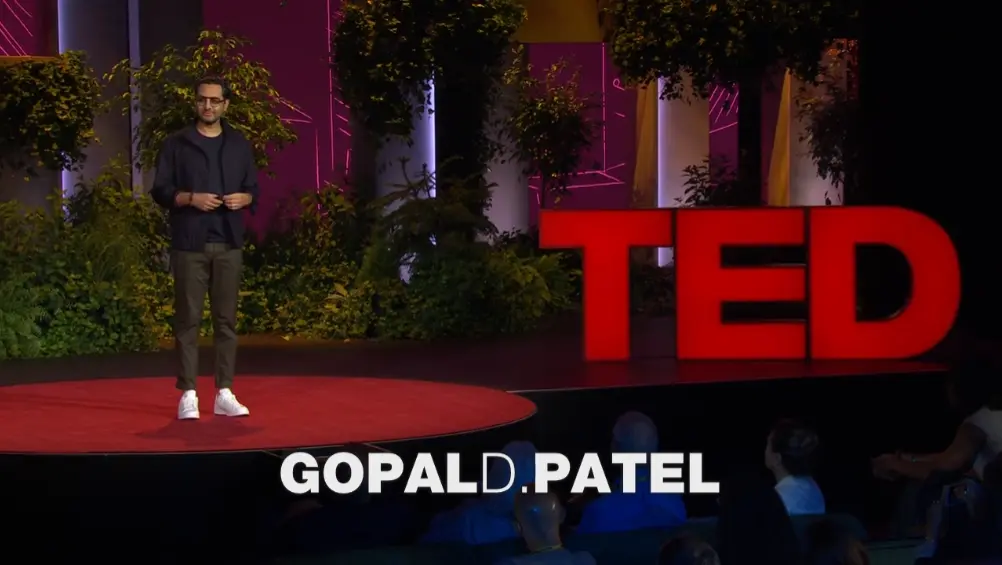I’m going to start with a story. In 1730, in India, the king of Jodhpur wanted to build a new palace, and he needed a large number of trees to be cut. Alarmed at hearing this, a group of local environmental activists went to protect the trees by throwing their arms around them. We could consider them the first-ever tree huggers.
00:26
Now, while this story might be known to many of us, what’s often less known is what motivated these activists. They came from the Bishnoi community, a Hindu lineage founded on 29 principles of environmental care. This is just one of so many amazing examples, throughout the world, of religious communities stepping up to protect the environment through addressing climate change, restoring ecosystems and protecting biodiversity. And I’ve had the honor and the privilege of working with many such groups in different parts of the world for environmental action.
01:07
But before I did that, I actually was living in India, where I spent time in a Hindu ashram on the banks of the sacred river Ganges, where I was studying Hindu spirituality and how the teachings of the Bhagavad Gita could be applied to contemporary concerns in the world. And it was this orientation of an engaged religion and spirituality that brought me to the climate movement in 2010. And since then, I think like many of us, I have experienced the highs and the lows as we’ve campaigned and advocated to keep the global temperature increase to 1.5 degrees.
01:50
And I don’t know about you, but I think right now, it can feel like it’s a difficult time to be working on climate change. Sometimes, things just don’t seem to be moving as quickly as we would like. And more often than not, unfortunately, we might be feeling scared or stuck, hopeless or maybe even burnt out.
02:11
Coming from the faith sector, I’ve always been interested in other ideas that are rooted in religion and spirituality that can support the broader environmental movement. I started looking into the history of religious and spiritual groups, and started thinking that they could be some of the most enduring social movements in the history of the world. They’ve been able to survive through multiple generations, adapt to changing situations, reform and revive themselves when needed. They’ve even inspired the leaders of some of the most iconic social movements in recent history, such as Mahatma Gandhi and Martin Luther King Jr.
02:50
That’s why I was really happy when a friend of mine, who was writing a book about Hindu approaches to pastoral care, asked me to contribute a chapter. Using my previous background as a university chaplain, I developed a framework that I thought could help people suffering from climate trauma. And as I went around sharing this framework with people from different backgrounds, they told me that it really resonated with them. The framework, although initially built for climate trauma, I think can really help with something I believe we need now in the climate movement: building resiliency and keeping momentum.
03:27
There are three core interconnected parts to this framework that are drawn from across a variety of religious and spiritual traditions. I’m excited to share that with you, and I’m going to use the Sanskrit words to explain the different aspects of the framework.
03:43
We begin with “sangha,” nourishing and uplifting community, where people come together to support one another and reaffirm social ties. This can happen weekly, monthly, or at different times of the year. So, for example, my Christian friends, they go to church on a Sunday. My Muslim friends go to prayer on a Friday, and my Hindu friends, they will gather at major festivals, such as Diwali.
04:15
We then have “sadhana,” rituals and traditions that give us a sense of belonging. This can often be fasting at times of the year, or going on pilgrimage, or retelling stories that have been passed down for multiple generations. Buddhists will go on pilgrimage to Gaya, where the Buddha found enlightenment. Jewish families and communities will retell the stories of their ancestors when they gather for their holidays.
04:47
And then, we have “seva,” purposeful action. These groups gave guidance and teachings for how to show up in the world, how to care for one another and the planet. In the Jain tradition, there is a focus on leading a life based on nonviolence. Members of the Baha’i faith are encouraged to be anxiously concerned with the needs of the world.
05:14
We do these things on a regular basis, but there are two ways that religious and spiritual groups engage in these practices that set them slightly apart. The first is intention. When religious and spiritual groups engage in these practices, they do them with a sense of importance, recognize that these are core functions of what it means to be part of that group.
05:37
Let’s illustrate that with an example from the climate movement. Let’s look at the Fridays for Future school strike. That was an example where some real focused intention yielded amazing results. By performing a very simple activity, not going to school on Fridays, they were able to build a community, a simple ritual and a purposeful action. And by doing so, they built resiliency amongst themselves and motivated millions of people around the world, that change was possible.
06:11
Now, if we bring these three practices together, along with the intention, something really magical starts to happen. This is the second special feature that religious and spiritual groups bring to these practices. It’s something that provides the ultimate grounding and narrative and meaning for why community, rituals and action are important. I call it “the big idea.”
06:42
For religious and spiritual groups, the big idea is often a sense of the divine, of God, or a metaphysical understanding of the world, or a grand narrative of a people throughout time. Whatever it is, the big idea usually has some common characteristics to it. It’s usually something that has existed before us and will exist after us. The big idea is not limited to a certain moment, time or place.
07:16
Now I’m getting some worried looks in the audience. Don’t worry, I’m not asking all of us to go out there and start looking for God. But I am suggesting that we may benefit from being part of something bigger than ourselves, and that can take many different forms.
07:32
For many people I meet in the climate movement, their big idea is being part of and connected to nature, and appreciating the beauty of the natural world. But it can also be a sense of connection we feel to our ancestors and the responsibility we have to future generations. It can also be a sense of wonder about the world, space and all that exists. Or yes, the big idea could be a belief in something bigger than ourselves that we can’t quite fully understand, but the presence of which we feel from time to time.
08:10
The big idea, the intention, and these three practices, when coming together, are extremely powerful and are bigger than the sum of their parts.
08:22
For me, my big idea is that the Earth is a goddess. In Sanskrit, she is called Bhumi. She is the life-giving source that nourishes me and all that exists. In order to sustain this idea, I make sure I have a community of people around me who believe similarly. Every morning, I have a simple ritual where I offer her my worship, thanking her for all that she provides. And I try to show up in the world with meaningful action, treating her with the love, respect and compassion that she deserves.
09:04
As we stand in this moment of time together, with all of the data and science before us, I believe we need to equip ourselves with every tool and resource possible. My invitation to all of us is that we all find our big idea and create communities, rituals and practices with renewed intention and purpose.
09:33
This framework not only has the potential to help us build resiliency and momentum, but it can profoundly transform the world. It has worked for people and communities for thousands of years, and perhaps it could work for us now.
09:54
Thank you.
Resources:
Hindu Approaches to Spiritual Care
Vineet Chander and Lucinda Mosher | Jessica Kingsley Publishers, 2019 | Book | Amazon
Gopal’s talk is based on a chapter he contributed to in this book.
“Climate and Nature: The Role of Faith-Based Organizations in Securing a Nature Positive World”
WWF Climate and Energy | YouTube, 2021 | Watch
A panel on faith perspectives on nature-based solutions held during the 2021 UN Climate Change Conference. Gopal spoke alongside representatives from the Baháʼí, Brahma Kumaris, Christian and Buddhist faiths.
The Bhagavad Gita: Talks Between the Soul and God
Ranchor Prime | Mandala Publishing, 2021 | Book | Amazon
An easy and accessible translation, written by a friend and mentor of Gopal’s from England
Source
Image Source
Tags: Environmental activist Gopal D. Patel, Ted Talk - Spirituality and Climate Change, Ted Talks


